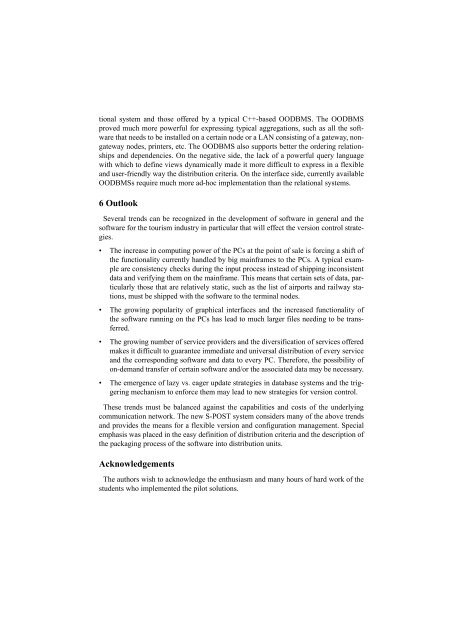Database Support for PC Software Configuration and Version ... - DVS
Database Support for PC Software Configuration and Version ... - DVS
Database Support for PC Software Configuration and Version ... - DVS
You also want an ePaper? Increase the reach of your titles
YUMPU automatically turns print PDFs into web optimized ePapers that Google loves.
tional system <strong>and</strong> those offered by a typical C++-based OODBMS. The OODBMS<br />
proved much more powerful <strong>for</strong> expressing typical aggregations, such as all the software<br />
that needs to be installed on a certain node or a LAN consisting of a gateway, nongateway<br />
nodes, printers, etc. The OODBMS also supports better the ordering relationships<br />
<strong>and</strong> dependencies. On the negative side, the lack of a powerful query language<br />
with which to define views dynamically made it more difficult to express in a flexible<br />
<strong>and</strong> user-friendly way the distribution criteria. On the interface side, currently available<br />
OODBMSs require much more ad-hoc implementation than the relational systems.<br />
6 Outlook<br />
Several trends can be recognized in the development of software in general <strong>and</strong> the<br />
software <strong>for</strong> the tourism industry in particular that will effect the version control strategies.<br />
• The increase in computing power of the <strong>PC</strong>s at the point of sale is <strong>for</strong>cing a shift of<br />
the functionality currently h<strong>and</strong>led by big mainframes to the <strong>PC</strong>s. A typical example<br />
are consistency checks during the input process instead of shipping inconsistent<br />
data <strong>and</strong> verifying them on the mainframe. This means that certain sets of data, particularly<br />
those that are relatively static, such as the list of airports <strong>and</strong> railway stations,<br />
must be shipped with the software to the terminal nodes.<br />
• The growing popularity of graphical interfaces <strong>and</strong> the increased functionality of<br />
the software running on the <strong>PC</strong>s has lead to much larger files needing to be transferred.<br />
• The growing number of service providers <strong>and</strong> the diversification of services offered<br />
makes it difficult to guarantee immediate <strong>and</strong> universal distribution of every service<br />
<strong>and</strong> the corresponding software <strong>and</strong> data to every <strong>PC</strong>. There<strong>for</strong>e, the possibility of<br />
on-dem<strong>and</strong> transfer of certain software <strong>and</strong>/or the associated data may be necessary.<br />
• The emergence of lazy vs. eager update strategies in database systems <strong>and</strong> the triggering<br />
mechanism to en<strong>for</strong>ce them may lead to new strategies <strong>for</strong> version control.<br />
These trends must be balanced against the capabilities <strong>and</strong> costs of the underlying<br />
communication network. The new S-POST system considers many of the above trends<br />
<strong>and</strong> provides the means <strong>for</strong> a flexible version <strong>and</strong> configuration management. Special<br />
emphasis was placed in the easy definition of distribution criteria <strong>and</strong> the description of<br />
the packaging process of the software into distribution units.<br />
Acknowledgements<br />
The authors wish to acknowledge the enthusiasm <strong>and</strong> many hours of hard work of the<br />
students who implemented the pilot solutions.















